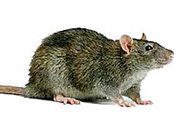What Makes Residential Gardens Attractive To Destructive Rats?
Norway rats excavate ground burrows for the purpose of nesting, and they typically contain a tunnel entrance that leads to a food source. These burrows are usually a few feet deep but they can exceed depths of 6 feet. Ground burrows are constructed to have one small inconspicuous entrance hole, as well as two additional exit holes located away from the main entrance. These access holes are around 2 to 4 inches in diameter. Rats go to great lengths to make their ground burrows difficult for their predators to notice, which is why the entrance and exit holes are as small as possible. On residential lawns, rats tend to establish their burrows in locations that are well hidden, such as beneath shrubs, in garden beds, beneath compost piles, beneath wood piles, and beneath bundles of leaf-litter. Rats are also known for burrowing against foundation walls, which sometimes extend beneath homes and lead into an interior space. Rat burrows typically accommodate a family of around eight rats.
Rats may consume fruits, vegetables and even ornamental plants in some cases, but rats require meat and fats, which makes gardens alone insufficient to support a rat colony. Compost piles that contain meats, fats, oils and grains provide an attractive food source for rats, and rats will also exploit the heat that compost piles radiate. In order to protect compost piles from the destructive habits of rats, compost should be encased within a plastic or steel container with a tight-fitting lid. Placing food, bird feed, or pet food outdoors is not advised, as rats develop a close attachment to properties where food sources are regularly and easily accessible. Homeowners experiencing rat pest issues in their garden should keep their plants at least 18 inches from foundation walls, and branches and shrubs should not make contact with exterior walls. Maintaining a defined space between foundation walls and vegetation will deprive rats of cover, and will therefore prompt them to relocate to a safer area.
Has your garden ever sustained damage from rat pests?


Comments are closed.